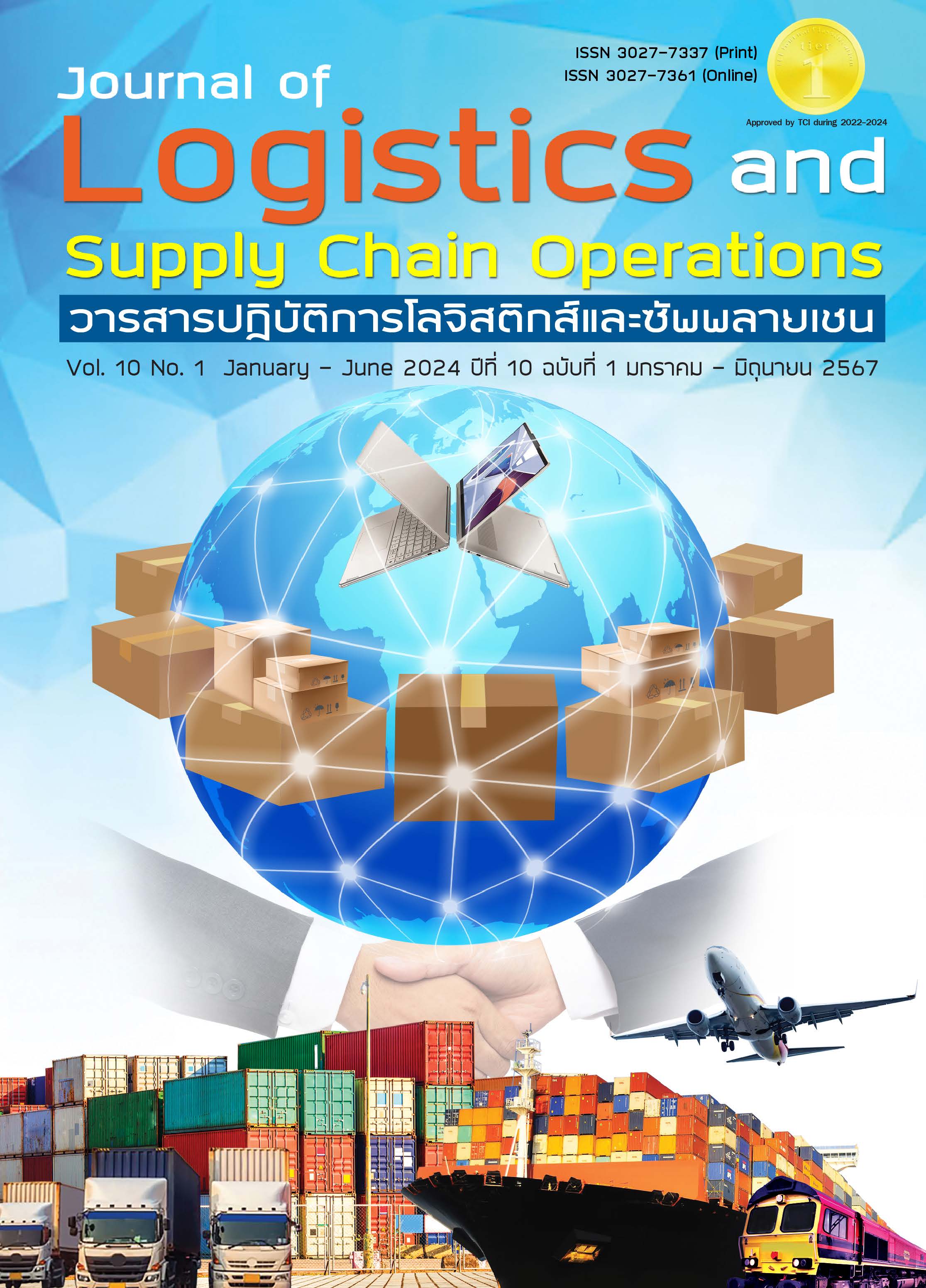การจัดลำดับความสำคัญของตัวชี้วัดประสิทธิภาพการจัดการคลังสินค้า โดยการประยุกต์ใช้วิธีกระบวนการวิเคราะห์ตามลำดับชั้น: กรณีศึกษา ผู้ให้บริการโลจิสติกส์บุคคลที่สามในจังหวัดปทุมธานี
DOI:
https://doi.org/10.53848/jlscc.v10i1.264756คำสำคัญ:
กระบวนการวิเคราะห์ตามลำดับชั้น, ประสิทธิภาพการจัดการคลังสินค้า, ผู้ให้บริการคลังสินค้า, ผู้ให้บริการโลจิสติกส์บุคคลที่สามบทคัดย่อ
การศึกษาครั้งนี้มีวัตถุประสงค์เพื่อจัดลำดับความสำคัญของมาตรวัดประสิทธิภาพของการจัดการคลังสินค้า การวิจัยเป็นแบบผสมวิธีวิทยา (Mixed methodology) คือ การวิจัยประยุกต์ (Applied research) และ การวิจัยเชิงคุณภาพ (Qualitative research) โดยใช้วิธีกระบวนการวิเคราะห์ตามลำดับชั้น (AHP) เพื่อจัดลำดับความสำคัญของประสิทธิภาพคลังสินค้าในอุตสาหกรรมโลจิสติกส์ของบุคคลที่สาม ข้อมูลถูกรวบรวมแบบเจาะจงจากกรณีศึกษาจำนวน 32 ชุด โดยทั้งหมดเป็นผู้จัดการคลังสินค้า หรือผู้จัดการโครงการ หรือ ผู้บริหารคลังสินค้าที่มีประสบการณ์ด้านการบริหารคลังสินค้า โดยผู้วิจัยพิจารณาจากค่าความสอดคล้อง (Consistency ratio) ของคำตอบที่ได้จากการวิจัยไม่เกิน 10% ครบทุกเกณฑ์ ผลการศึกษาพบว่า เกณฑ์ประสิทธิภาพคลังสินค้าที่ผู้ให้บริการโลจิสติกส์ให้ความสำคัญเป็นอันดับแรกคือ ความน่าเชื่อถือ 40.7% ที่สองคือระยะเวลารอคอย 21.4% และที่สามต้นทุน 14.7% การพิจารณาเกณฑ์ย่อยที่จัดเรียงจากมากไปหาน้อย 5 อันดับ คือ จัดส่งตรงเวลา (27.4%) ตามด้วยความแม่นยําของบันทึกสินค้าคงคลัง (13.3%) เวลาตอบสนองของลูกค้า (12.6%) ความสัมพันธ์กับลูกค้า (6.2%) และเวลาการขนส่ง (6.1%) ตามลำดับ ซึ่งผลการศึกษาจะช่วยให้ผู้ให้บริการคลังสินค้าและผู้ให้บริการโลจิสติกส์ที่เกี่ยวข้องสามารถให้ค่าน้ำหนักความสำคัญ พัฒนา และประยุกต์ใช้ตัวบ่งชี้การวัดประสิทธิภาพคลังสินค้าของตนได้อย่างเหมาะสม
References
กัลยา วานิชย์บัญชา. (2559). สถิติสำหรับงานวิจัย. พิมพ์ครั้งที่ 16, กรุงเทพฯ: สำนักงานพิมพ์จุฬาลงกรณ์มหาวิทยาลัย.
ศราวุธ ไชยธงรัตน์ และณัฐพัชร์ อารีรัชกุลกานต์. (2564). ประยุกต์ใช้กระบวนการวิเคราะห์เชิงลำดับชั้นในการคัดเลือกผู้ขายอย่างยั่งยืน กรณีศึกษา บริษัทเอบีซี. วารสารวิทยาลัยโลจิสติกส์และซัพพลายเชน, 7(2), 5- 17.
ศูนย์วิจัยกรุงศรี. (2565). แนวโน้มธุรกิจ/อุตสาหกรรมปี 2565-2567: ธุรกิจคลังสินค้า. ค้นเมื่อ 12 ธันวาคม 2565, จาก: https://www.krungsri.com/th/research/industry/industry-outlook/logistics/warehouse-space/io/io-warehouse-space-2022.
ศูนย์วิจัยกสิกรไทย. (2565). B2C E-Commerce ปี’ 65-66. เติบโตชะลอลงจาก ปัจจัยกดดันด้าน กำลังซื้อ. ค้นเมื่อ 11 ธันวาคม 2565, จาก: https://www.kasikornresearch.com/th/analysis/k-econ/business/Pages/B2C-E-Commerce-z3361.
Alzoubi, H. (2018). The role of intelligent information system in e-supply chain management performance. International Journal of Multidisciplinary Thought, 7(2), 363-370.
Brazhkin, V. (2018). Outside the Box Warehousing: When Thinking of Inputs as Outputs Makes Sense. Transportation Journal, 57(2), 219-232.
Eaidgah, Y., Abdekhodaee, A., Najmi, M., & Arab Maki, A. (2018). Holistic performance management of virtual teams in third-party logistics environments. Team Performance Management, 24(3/4), 186-202.
Esmaeili, M., Naghavi, M. S., & Ghahghaei, A. (2018). Optimal (R, Q) policy and pricing for two-echelon supply chain with lead time and retailer’s service-level incomplete information. Journal of Industrial Engineering International, 14(1), 43-53.
Faber, N., De Koster, R. B., & Smidts, A. (2018). Survival of the fittest: the impact of fit between warehouse management structure and warehouse context on warehouse performance. International Journal of Production Research, 56(1-2), 120-139.
Fattahi, M., Govindan, K., & Keyvanshokooh, E. (2017). Responsive and resilient supply chain network design under operational and disruption risks with delivery lead-time sensitive customers. Transportation Research Part E: Logistics and Transportation Review, 101, 176-200.
Frazelle, E. H. (2016). World-class warehousing and material handling. New York:McGraw-Hill Education.
Guthrie, B., Parikh, P. J., & Kong, N. (2017). Evaluating warehouse strategies for two-product class distribution planning. International Journal of Production Research, 55(21), 6470-6484.
Hilmola, O. P., & Tolli, A. (2018). Evaluation of Chinese E-commerce cost and Lead time performance to Estonia. Quality Innovation Prosperity, 22(1), 14-26.
Hoseini Shekarabi, S. A., Gharaei, A., & Karimi, M. (2019). Modelling and optimal lot-sizing of integrated multi-level multi-wholesaler supply chains under the shortage and limited warehouse space: generalised outer approximation. International Journal of Systems Science: Operations and Logistics, 6(3), 237-257.
Johnson, A.L., & McGinnis, L.F. (2010). Performance measurement in the warehousing industry. IIE Transactions, 43, 220 - 230.
Karim, N.H., Abdul Rahman, N.S.F., Md Hanafiah, R., Abdul Hamid, S., Ismail, A., Abd Kader, A.S., & Muda, M.S. (2021). Revising the warehouse productivity measurement indicators: ratio-based benchmark. Maritime Business Review, 6(1), 49-71.
Khan, S. A., Dweiri, F., & Chaabane, A. (2016). Fuzzy-AHP approach for warehouse performance measurement. IEEE International conference on industrial engineering and engineering management (IEEM), 4-7 December 2016 at Bali, 871-875.
Kłodawski, M., Jacyna, M., Lewczuk, K., & Wasiak, M. (2017). The issues of selection warehouse process strategies. Procedia Engineering, 187, 451-457.
Laosirihongthong, T., Adebanjo, D., Samaranayake, P., Subramanian, N., & Boon-itt, S. (2018). Prioritizing warehouse performance measures in contemporary supply chains. International Journal of Productivity and Performance Management, 67(9), 1703-1726.
Lu, W., McFarlane, D., Giannikas, V., & Zhang, Q. (2016). An algorithm for dynamic order-picking in warehouse operations. European Journal of Operational Research, 248(1), 107-122.
Luo, H., Yang, X., & Kong, X. T. (2019). A synchronized production-warehouse management solution for reengineering the online-offline integrated order fulfillment. Transportation Research Part E: Logistics and Transportation Review, 122, 211-230.
MacKenzie, S. B., & Lutz, R. J. (1989). An empirical examination of the structural antecedents of attitude toward the ad in an advertising pretesting context. The Journal of Marketing, 52(2), 48-65.
Mourtzis, D., Samothrakis, V., Zogopoulos, V., & Vlachou, E. (2019). Warehouse design and operation using augmented reality technology: A papermaking industry case study. Procedia Cirp, 79, 574-579.
Peng, D. X., & Lu, G. (2017). Exploring the impact of delivery performance on customer transaction volume and unit price: evidence from an assembly manufacturing supply chain. Production and Operations Management, 26(5), 880-902.
Rahdar, M., Wang, L., & Hu, G. (2018). A tri-level optimization model for inventory control with uncertain demand and lead time. International Journal of Production Economics, 195, 96-105.
Ramli, A., Bakar, M. S., Pulka, B. M., & Ibrahim, N. A. (2017). Linking human capital, information technology and material handling equipment to warehouse operations performance. International Journal of Supply Chain Management, 6(4), 254-259.
Rao, S., Ellis, S. C., Goldsby, T. J., & Raju, D. (2019). On the “Invisible Inventory Conundrum” in RFID‐Equipped Supply Chains: A Data Science Approach to Assessing Tag Performance. Journal of Business Logistics, 40(4), 339-358.
Saaty, T. L. (2004). Decision making—the analytic hierarchy and network processes (AHP/ANP). Journal of systems science and systems engineering, 13(1), 1-35.
Student. (1992). The probable error of a mean. Breakthroughs in Statistics: Methodology and Distribution, 33-57
Tannady, H., Gunawan, F. E., & Tus, M. L. V. (2019). Redesigning Warehouse Layout Based on Warehouse Management System Policy to Minimize Material Handling Cost. International Journal of Mechanical Engineering and Technology, 10(5), 61-76.
Torabizadeh, M., Yusof, N. M., Ma’aram, A., & Shaharoun, A. M. (2020). Identifying sustainable warehouse management system indicators and proposing new weighting method. Journal of Cleaner Production, 248, 119-190.
Tuo, G., Feng, Y., & Sarpong, S. (2019). A configurational model of reward-based crowdfunding project characteristics and operational approaches to delivery performance. Decision Support Systems, 120, 60-71.
Wang, Y., & Sun, S. (2010). Assessing beliefs, attitudes, and behavioral responses toward online advertising in three countries. International Business Review, 19(4), 333–344.
Xia, D. F., Xu, S. L., & Qi, F. (1999). A proof of the arithmetic mean-geometric mean-harmonic mean inequalities. RGMIA research report collection, 2(1), 84-87.
Yadav, A. S., & Swami, A. (2019). A volume flexible two-warehouse model with fluctuating demand and holding cost under inflation. International Journal of Procurement Management, 12(4), 441-456.


